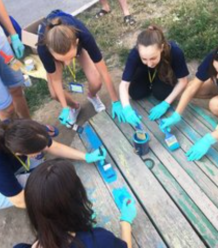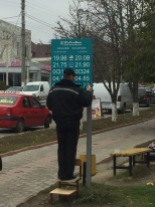These three photos show what’s happened to the U.S. dollar during the past several months.
I shot all of the photos here in Ialoveni, Moldova: the left one on October 26, the middle one on April 3 and the right one this past Wednesday, August 2. As you can see, a dollar sold here for 19.98 Moldovan lei on October 26, before briefly climbing above 20. Now it sells for only 17.89 lei, a decline of more than 10 percent.
That’s consistent with what’s been happening to the dollar around the world, as the New York Times reported on Tuesday, juxtaposing the dollar’s decline with a rise in the U.S. stock market.
How does this affect Peace Corps volunteers in Moldova? Actually, not much. We are paid in Moldovan lei, buy things in lei and have little reason to track exchange rates. Champa and I have lived comfortably within our Peace Corps budget, so have never sold U.S. dollars for lei except when we first arrived and exchanged a small amount. We rarely use our credit cards since Moldova is largely a cash economy. We also don’t buy much online, transactions generally calculated in dollars anyway.

Many Moldovans work abroad and send money home, so exchange rates matter to them.  However, they generally pay more attention to the Euro than the dollar; indeed, prices for some goods and services here are quoted in Euros rather than lei, as we learned when we considered renting an apartment. The Euro has not fluctuated as much as the dollar recently.
However, they generally pay more attention to the Euro than the dollar; indeed, prices for some goods and services here are quoted in Euros rather than lei, as we learned when we considered renting an apartment. The Euro has not fluctuated as much as the dollar recently. 
Banks and money exchange centers here also focus on the Romanian leu, the Russian ruble and the Ukrainian hryvnia — not so different from Americans paying attention to neighboring currencies such as the Mexican peso or the Canadian dollar.
Peace Corps Moldova calculates its budget annually, so it’s not affected immediately by currency shifts except in a few ways. For example, a small percentage of volunteer paychecks is designated for personal travel and pegged to exchange rates. The overall impact is so small, though, that many volunteers probably didn’t notice the recent dip.  (That included me until I started writing this post.)
(That included me until I started writing this post.)
Moldova faces serious economic challenges but currency fluctuations here have been far less dramatic than in some Peace Corps countries. The agency’s financial planners elsewhere sometimes have to scramble in response to big swings, as do the State Department and other parts of the U.S. government, along with international companies, travelers and others.
A few months before we arrived here in June 2016, the dollar was even lower than it is now, so the rise above 20 may have been outside the usual range. I’m told it was a response to Brexit, the U.S. presidential election, Federal Reserve policy and other things I cannot claim to fully understand, much less explain here.
Nor do I really care. For me, a person who enjoys math and numbers, it’s just been something to notice occasionally as I walk to work.
One doesn’t become a Peace Corps volunteer to get rich. For all of us serving in more than 60 countries around the world, our mission is to serve our local communities and promote friendship between Americans and other people. Ultimately, that’s the currency that matters, not the ones shown on the ever-changing bank signs.
Did you enjoy this post? Please share it!

 In other words … well, yes: in other words. It made for an interesting dinner. I tried to speak French with the boyfriend (shown here, with the beard) since I studied it in high school and once spoke it fairly well. But it was frustrating. I understood much of what he said but sputtered in Romanian when I tried to reply.
In other words … well, yes: in other words. It made for an interesting dinner. I tried to speak French with the boyfriend (shown here, with the beard) since I studied it in high school and once spoke it fairly well. But it was frustrating. I understood much of what he said but sputtered in Romanian when I tried to reply. 




















 Bolts of velvet, cotton and other material surrounded many of the shops we visited. Champa and her partners visited one place after another to select the best cloth for the costumes they’re planning. They also bought buttons, gold braid, ribbons and other haberdashery supplies. Within a few hours, we were loaded down with bags, which we carried on a bus across town to Ina’s studio. She is now cutting and assembling the cloth for each costume — Romeo, Juliet, kings, queens and more.
Bolts of velvet, cotton and other material surrounded many of the shops we visited. Champa and her partners visited one place after another to select the best cloth for the costumes they’re planning. They also bought buttons, gold braid, ribbons and other haberdashery supplies. Within a few hours, we were loaded down with bags, which we carried on a bus across town to Ina’s studio. She is now cutting and assembling the cloth for each costume — Romeo, Juliet, kings, queens and more.




 The program, whose full name is Girls Leading Our World – Teaching Our Boys Excellence, began in Romania in 1995 and has spread around the world with Peace Corps support. Here in Moldova, volunteers work with local counterparts to provide activities ranging from leadership workshops to singing, dancing, making S’Mores and tie-dying T shirts. The program continues throughout the year with activities across Moldova.
The program, whose full name is Girls Leading Our World – Teaching Our Boys Excellence, began in Romania in 1995 and has spread around the world with Peace Corps support. Here in Moldova, volunteers work with local counterparts to provide activities ranging from leadership workshops to singing, dancing, making S’Mores and tie-dying T shirts. The program continues throughout the year with activities across Moldova.

 More than 12,000 readers have visited “Not Exactly Retired” since its launch two years ago. I was curious where all of you are located, so recently ran a search on WordPress, which hosts the site.
More than 12,000 readers have visited “Not Exactly Retired” since its launch two years ago. I was curious where all of you are located, so recently ran a search on WordPress, which hosts the site. Some of the other “Top Dozen,” though, surprised me. Who are all of you reading “Not Exactly” in Ecuador or the Philippines? Are you fellow Peace Corps Volunteers in those countries? How about in India, Germany and Italy? I know at least one loyal reader in Singapore (hi Corinna!), but who are the rest of you? The data provided by WordPress provide only a glimpse.
Some of the other “Top Dozen,” though, surprised me. Who are all of you reading “Not Exactly” in Ecuador or the Philippines? Are you fellow Peace Corps Volunteers in those countries? How about in India, Germany and Italy? I know at least one loyal reader in Singapore (hi Corinna!), but who are the rest of you? The data provided by WordPress provide only a glimpse.












 Those trainees held their community service event last week, a clean-up of Sociteni’s main street.
Those trainees held their community service event last week, a clean-up of Sociteni’s main street. Two other groups of trainees— in English education and health education — will also swear in next week.
Two other groups of trainees— in English education and health education — will also swear in next week.  Altogether, more than 50 trainees are expected to join Peace Corps Moldova’s current volunteers, most of whom swore in a year ago and will continue serving until next summer, Champa and me among them.
Altogether, more than 50 trainees are expected to join Peace Corps Moldova’s current volunteers, most of whom swore in a year ago and will continue serving until next summer, Champa and me among them.














 However, they generally pay more attention to the Euro than the dollar; indeed, prices for some goods and services here are quoted in Euros rather than lei, as we learned when we considered
However, they generally pay more attention to the Euro than the dollar; indeed, prices for some goods and services here are quoted in Euros rather than lei, as we learned when we considered 
 (That included me until I started writing this post.)
(That included me until I started writing this post.)